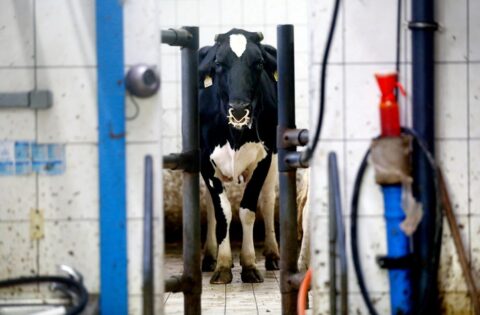Is New York City Getting its Composting Program Right?
Climate•10 min read
Reported
There is an indisputable link between the climate crisis and animal agriculture. But let's make one thing clear. Farm animals are not making the climate crisis worse - we are.


Words by Matthew Zampa
The human appetite for meat and dairy is brewing a special kind of disaster.
In mainstream media headlines, in industry-backed scientific research, and perhaps most frighteningly, in the minds of the world’s decision-makers, climate change is rarely if ever linked to the environmental impacts of intensive livestock farming. Although by now, the connection is indisputable.
New research suggests that the livestock industry is responsible for at least 37 percent of all greenhouse gas (GHG) emissions. This new number more than doubles the United Nations’ latest estimate of 14.5 percent, taking into account more than 94 different studies and key data points left out of other analyses, like the foregone carbon absorption from clearing land for livestock and feed production. As the demand for conventional meat continues to rise, emissions from the animal farming industry will drive global temperatures even higher.
There are two big problems with farming animals.
First, it is incredibly inefficient. According to a landmark study published in Science in 2018, which includes data from nearly 40,000 farms and 1,600 packaging types and retailers, animal agriculture provides just 18 percent of calories and takes up 83 percent of farmland.
Second, the scientific community can’t seem to agree on how much the livestock industry is contributing to the climate crisis. Since 2006, researchers and policymakers around the world have relied on inconsistent data and estimates, ranging from 14.5-51 percent of total GHG emissions.
The latest Intergovernmental Panel on Climate Change (IPCC) report is largely based on the 14.5 percent figure put out by the Food and Drug Administration (FAO) of the United Nations. Even with the FAO’s estimate, which is far too low, the recommendations are still dire. The report states that all of the consequences of climate change will be worsened if the global food system does not become more sustainable.
It has been all of four weeks since the latest IPCC report called for an overhaul of the global food system, and the UN’s warning has already disappeared from the headlines. That should come as no surprise, though. Industries like transportation and energy production frequently overshadow the huge environmental impact farming animals has on the environment.
Farming animals is both land- and carbon-intensive. Farmed animals like cows, chickens, and pigs produce large amounts of methane gas and require pastures that will be threatened by soil damage and desertification as temperatures continue to rise.
When land is cleared of forest for cattle grazing, soy, and other feed crops, it loses the potential for carbon absorption, also called carbon capture, which occurs when carbon is removed from the atmosphere by trees and stored in the soil. As a result, a net positive becomes a net negative. The carbon-absorbing forest becomes a dry, fire-prone patch of earth.
Livestock currently occupies about 45 percent of the global surface area. At the current rates of deforestation, the Amazon will not be the only ancient forest burned so the world can eat beef. In the years to come, vital habitats will be increasingly exploited to meet the global demand for meat, which the FAO projected to rise by 73 percent between 2010 and 2050.
By then, scientists believe it may be too late. The current food system is doing more harm to the environment today than at any time in recorded history, largely because of the prevalence of meat-heavy diets.
Since 1961, meat production has increased at a staggering rate. The world produces nearly five times more meat today than it did 50 years ago, about 317 million tons in 2014. The industry has increasingly relied on intensive animal farming, often called factory farming, to satisfy the steady rise in demand for animal products and artificially inflate the carrying capacity of the current food system.
Chickens were the first animals to be farmed at a large-scale. At the time, scientists believed there would be no way to continue feeding animal products to a rapidly growing human population without farming animals more efficiently. So they stuck animals in barns, crammed them in cages, and turned the farm into a well-oiled machine.
What they failed to recognize is that the diet they were feeding was just as unsustainable as the animals that came with it.
For every one human, there are about three farm animals alive today. That means there are roughly 22.5 billion more cows, chickens, goats, and pigs living on farms and in pastures around the world than would otherwise be there if nature was allowed to take its course.
It’s worth pointing out that all of these animals were brought into existence by and for humans. Farm animals are not making the climate crisis worse – we are.
As global temperatures hurtle past the current post-industrial rise of 0.8 degrees Celsius and toward the benchmark 2-degree shift that many scientists now say is inevitable, meat-eaters will be hard-pressed to pick a more climate-friendly diet.
In the meantime, the meat industry is hedging its bets on keeping the climate crisis a secret. They’re doing a pretty good job at it, too. Despite the budding cultural awareness of the link between climate change and animal agriculture, people are still eating record amounts of meat. In the United States, Europe, Britain, Australia, and Canada, the Western diet – notoriously heavy in animal products and processed foods – is contributing more to climate change than any other diet on the planet.
The average American eats over 200 pounds of meat per year. That’s equivalent to eating about 800 hamburgers and adding more emissions to the atmosphere per gram than any equivalent source of protein.
[infogram id=”e718f988-0405-4a50-9d13-7ac1d08952e0″ prefix=”Zzh” format=”interactive” title=”Beef's big carbon footprint”]
All figures are based on global averages. (Poore and Nemecek 2018)
More than a quarter of global emissions come from food. On top of that, over half (58%) of food emissions come from animal products, and half of all farmed animal emissions come from lamb and beef.
But it goes both ways.
“Climate change is impacting agriculture in so many ways,” says climate scientist Ryan Towell, who got his start reporting on severe weather as a meteorologist for local news station KAMC-TV in West Texas. “Certain varieties [of crops] can’t tolerate the intense heat, or the drought, or the flooding.”
Climate change poses a serious threat to the food supply, no matter where you are in the world or what you eat for breakfast. For the Southerners who can’t get enough fresh peaches and the Midwesterners drowning in corn, the future of food may look very different.
In the U.S., Towell explains, climate change might lead to less quantity of foods that rely on the crops like corn, wheat, and other grains threated by climate change, and they’re going to be more expensive at the grocery store. In poorer countries, he says, people may have a harder choice to make.
Corn is a major source of animal feed. Without a steady supply of corn, most Westerners will not be able to eat eight-hundred-hamburgers worth of meat in a year, and most Western countries won’t be able to produce and export the trillions of pounds of meat and dairy that they currently do to meet the massive global demand for animal products.
“The need for urgent action is becoming more clear by the day,” says Towell, now the Director of Science and Solutions at the Climate Reality Project. “We’re already seeing these impacts to our food and water supply and the expectation is that as the earth continues to warm, these impacts are going to intensify.”
 This story is part of Covering Climate Now, a global collaboration of more than 250 news outlets to strengthen coverage of the climate story.
This story is part of Covering Climate Now, a global collaboration of more than 250 news outlets to strengthen coverage of the climate story.